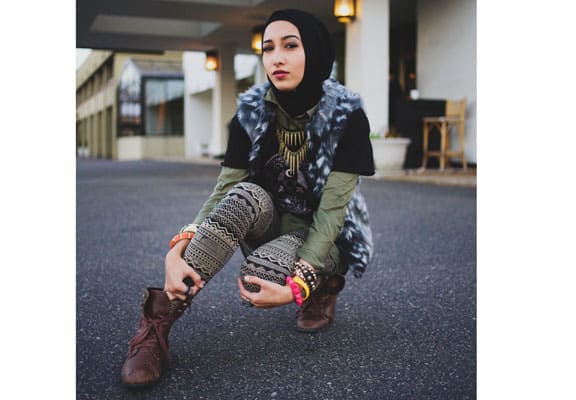

Credit: Langston Hues.
NEW YORK (WOMENSENEWS)–Long sleeves, low hemlines, flowing fabrics; all usually topped with a headscarf, or hijab, that covers the hair.
These timeless clothing elements are being put into trending fashion focus by designers, bloggers and stylists who go by a range of names: hijabistas, hijabis, turbanistas.
From tutorials on YouTube on how to wear a headscarf to specialized model agencies, bloggers and stylists are finding ways to celebrate the rules of modesty imposed by Islam.
Some post photographs of their outfits of the day or latest purchases on Facebook, which, along with blogs, Instagram and Pinterest are the most influential channels for women making decisions on apparel, according to a recent report from NetBase, the Mountain View, Calif., supplier of social media data.
Some of the Muslim hijabistas’ work appears in U.S.-based blogs such as The Hijablog and Modhijabi, where creators post daily pictures of their various outfits.
Imaan Ali, a Norwegian-born Iraqi blogger, is behind The Hijablog which she started in 2012 after a brief blogging experience in 2008. Her blog has attracted nearly 70,000 people on Facebook and over 10,000 followers on Instagram.
Ali is based in Ann Arbor, Mich., where she is a doctoral candidate in political science and an instructor at the University of Michigan. She describes herself as an activist and identifies herself on her blog as mainly concerned with issues pertaining to Arab politics, society, culture, Islam and women’s rights.
Her followers go well beyond other Muslim women. She said she has also a “lot of non-Muslim” viewers and international media that pay attention to her work as a “fashion stylist,” as she describes herself.
Muslim fashion leaders may be jolting popular stereotypes of passivity and submission that are tied to clothing that appears uniform, traditional and identity-concealing. Ninety-two percent of Muslim female respondents believed that Muslim fashion trends can lead to a positive change in the way they are perceived, according to a survey released in July by the Women’s Islamic Initiative in Spirituality and Equality, a program of the New York-based American Society for Muslim Advancement.
Avoiding Black Hijabs
Sana Rashid, another fashion blogger, began her blog, Modhijabi, less than a year ago. The American-Pakistani has worn the hijab since nineth grade. She says she avoids black hijabs because of their negative connotations in Western society.
“Regular societies like wearing black but when a Muslim woman wears it it’s because she is oppressed,” Rashid said. “If that’s how they interpret Muslim women then I believe you should stay away from black hijabs.”
Rashid welcomed Women’s eNews into her spacious home in New York City. She was wearing two of her favorite pieces: printed, front-pleated pants, a loose orange silk shirt paired with a navy blue silk veil and summer wedges.
Although Rashid tends to wear bright colorful and printed hijabs she still faces some stereotypes. “Everyone thinks that I am forced to wear the hijab when I am not,” Rashid said, adding that her mother didn’t wear the hijab.
Nailah Lymus is a New York-based fashion designer who in February 2012 founded the Underwraps Agency, which she describes as the first Muslim modeling agency.
“There has been an impact of Muslim women in the fashion industry over the years,” she told Women’s eNews recently, in an interview on the set of a photo shoot.
She mixes colors and patterns; layers lace and silk; mingles items of short and long length; and uses bold accessories. In photo shoots her models wear high-heeled platform shoes, bright and neon colors. Pants can be fashioned into head wraps.
Lymus herself wears loose and long clothes and rarely goes in for monochrome. She covers her hair in various ways. Some days she wears a traditional hijab that covers the chest, ears and neck. On other days, she ties her veil as a voluminous turban that leaves her neck exposed.
Wide-Reaching Market
The potential of this fashion market is hard to assess. But if half of the world’s 1.6 billion Muslims spent just $120 a year on clothing the global Muslim fashion industry would be worth $96 billion, according to French Fashion University Esmod in Dubai in the United Arab Emirates.
The modesty factor of Muslim fashion has a wide reach. Seventy percent of 700 respondents surveyed online said they couldn’t find anything completely covered yet fashionable when they go to the malls, according to a survey by Abaya Addict, a U.S. company based in Dubai. Ten percent of those who couldn’t find what they wanted at the mall were Christians looking for modest attire suitable to wear to church.
Mohammed Langston, who also goes by the name of Langston Hues, is a Detroit-based photographer who has photographed dozens of veiled Muslim women around the globe and gets plenty of “shares” and “likes” on Instagram.
It all started a few years ago when Langston was asked to shoot covered women for a Michigan-based project called “Beautifully Wrapped,” which showed the global influences–African, Middle Eastern and Western–of headscarves.
He agrees that Muslim fashion is gaining mainstream ground.
“You see a lot of these women being featured and interviewed in very secular mainstream fashion magazines and blogs,” he said in a phone interview. “In fact, you see in the fashion industry from the runways of New York to Paris to Los Angeles, designers are getting styles from these women. It is taking off! You have people like Rihanna who are also following some of these huge fashion turbanistas–women who adorn the turban style–and Muslim fashionistas.”
Hajer Naili is a New York-based reporter for Women’s eNews. She has worked for several radio stations and publications in France and North Africa and specializes in Middle East and North Africa. Follow her on Twitter @H_NAILI
Would you like to Comment but not sure how? Visit our help page at https://womensenews.org/help-making-comments-womens-enews-stories.
Would you like to Send Along a Link of This Story? https://womensenews.org/story/cultural-trendspopular-culture/130805/muslim-hijabistas-generate-growing-fashion-buzz

